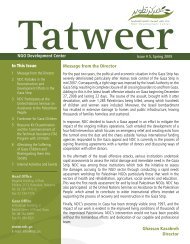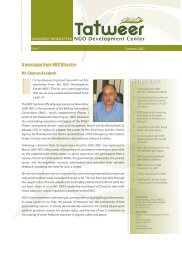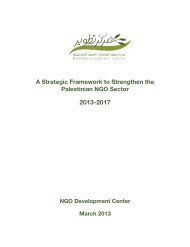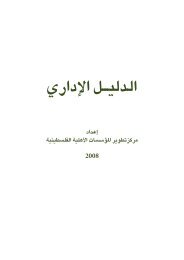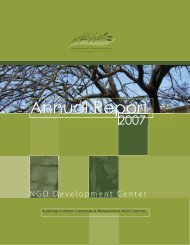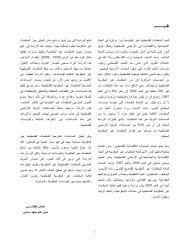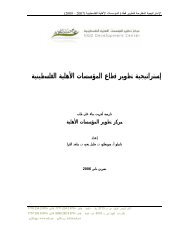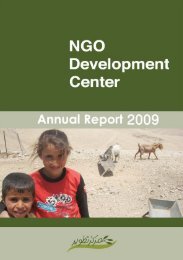Tracking External Donor Funding.pdf - NDC
Tracking External Donor Funding.pdf - NDC
Tracking External Donor Funding.pdf - NDC
You also want an ePaper? Increase the reach of your titles
YUMPU automatically turns print PDFs into web optimized ePapers that Google loves.
In 2006, 79.8% of PNGO funding in Rural Development<br />
came from the external donors. Most of the remainder<br />
came from self-financing. In 2006, PNGOs working in<br />
the Water and Environment sector were the most heavily<br />
dependent upon international aid, with a total of 93.4%<br />
of their funding financed from abroad 39 .<br />
Vocational Training<br />
The Vocational Training sector hits a peak in 2002<br />
during the height of the Intifada. before decreasing<br />
slightly into 2003. From 2004 to 2005 Vocational<br />
Training begins to decrease again before remaining<br />
steady between 2 and 3% through to 2008.<br />
INGO donors follow the overall trend closely.<br />
Governments do as well, with the exception of 2004<br />
where their funding does not begin to decrease. INGOs<br />
contributed less than Governmental donors in the earlier<br />
years, and more in the latter.<br />
In 2006, PNGOs in this sector received 72.5% of their<br />
funding from international aid, with almost all of the<br />
remainder coming from self-financing activities (MAS,<br />
2007:80).<br />
Other<br />
From what our researchers were able to gather about the<br />
small number of the donors who used this sector as a<br />
definition of their aid, activities focused around<br />
microfinance and capacity building for recipients. Any<br />
number of other activities however may be included.<br />
Without knowing what the activities are, from our<br />
previous studies we do know that PNGOs who fit into the<br />
Other sector receive 66.3% of their funding through<br />
external aid (MAS, 2007:80).<br />
Figure 24: <strong>External</strong> <strong>Donor</strong> <strong>Funding</strong> to PNGOs<br />
Working in Economic-Based Development (1999-2008)<br />
25%<br />
20%<br />
15%<br />
10%<br />
5%<br />
0%<br />
1999 2000 2001 2002 2003 2004 2005 2006 2007 2008<br />
Vocational Training<br />
Water and Environment<br />
Rural Development<br />
Other<br />
Source: MAS, 2009 – <strong>Donor</strong> Survey<br />
3.6.4.3 <strong>External</strong> <strong>Funding</strong> to Rights-Based<br />
Development PNGOs<br />
Human Rights<br />
<strong>External</strong> aid to Human Rights PNGOs peaked during the<br />
2002 height of the Intifada, before sharply declining into<br />
2003. Following this there is a steady decline until 2005,<br />
after which it plateaus to between 10 – 11% of total<br />
external aid to PNGOs. Much like Charity and Relief,<br />
Human Rights funding tends to correlate closely with<br />
political events, mainly crisis. However, as Figure 25<br />
shows, Human Rights spending remained at its peak<br />
from 2005 – 2008.<br />
The INGO donor sector follows the pattern of overall,<br />
while apportioning a smaller percentage of funding to the<br />
sector than Government donors. Governmental donors<br />
apportioned between 16 – 18% of their aid to the sector<br />
between 2001 and 2008. INGO donors, on the other<br />
hand, apportioned between five and seven percent over<br />
the same period. According to previous MAS mappings,<br />
75.8% of Human Rights PNGOs’ funding consists of<br />
external aid (MAS, 2007:80).<br />
39<br />
It should be noted that PARC receives the lion’s share of funding to this sector to the rural development, and often acts as a donor to smaller<br />
implementing PNGOs or CBOs. The same is largely true of the Palestinian Hydrology Group in the water and environment sector.<br />
40


